On 8/18 I woke up pretty early (for me) in my hostel in Osaka, 8:30am, and got ready for a scorching hot day in Kyoto! It cost me about 750 yen each way to get there and back again, but didn’t take terribly long, because the JR line has a special rapid train that gets you there in about 30 minutes.
Kyoto was the imperial capital of Japan for over 1,000 years, however, the imperial palace not resides in Tokyo so Kyoto has faced a significant demotion. Many consider Kyoto to be Japan’s cultural capital. Relatively little bombing took place in this city during World War II, and it was spared as a target for the atomic bombs by an American general.
I arrived at around 11am, without having eaten breakfast, and decided to save money by walking nearly everywhere. This was already a bad idea by itself on such a hot day. I had wanted to basically book it straight to a certain shrine that I had heard about from some friends, so I headed in that direction. My first impressions of Kyoto were not good at all. Near the main station is a huge mass of low quality housing and buildings, basically a slum. As I proceeded to get lost, I continued to see a lot of this. However, the people in these areas were very friendly and nice (as opposed to what I saw in Osaka).
After some backtracking, I wandered into a temple complex that had some really cool shrines, as well as some humongous wooden buildings. I’m not sure when these were built, but they were very old, and building them must have required a herculean effort. After wandering through here, I continued onward to my original destination, Fushimi-Inari shrine.
Fushimi-Inari is unique in a few ways. This shrine is a Shinto shrine dedicated to Inari, the god of rice. His messengers are foxes (kitsune), which explains the many hundreds of fox statues present. Additionally, this shrine has thousands of torii (gates) to walk through, and the visual effect is quite stunning. There are also hundreds of small shrines throughout the entire mountainside that houses this complex. At some point, I decided to take a “shortcut” that left me lost in a bamboo forest (worth it). The whole shrine was very beautiful, but a little hard to walk all the way through on such a hot day.
After getting un-lost from the bamboo forest, I mostly gave up on long-distance walking as I was getting pretty scorched and the back of my shirt was completely drenched. This sounded like a good time for a soak, so I headed to my next stop, the Funaoka Onsen! I took the train to a station that I thought was close to the destination, but it ended up being abother long hike. By the time that I was close, I had pretty bad chafing going on from my pants, and a headache from not eating (also some dehydration). So I stopped in at a convenience store for some quick snacks and water. Then I was ready for the baths.
Funaoka Onsen is not really an onsen, as its waters are electrically heated rather than natural heat. It’s actually a sento (public bath facility). This particular sento is quite famous due to it’s age, beauty, and entrance policy. Everyone (that can afford the 420 yen entry fee) is allowed to partake. This includes Yakuza members (Japan’s organized crime group, similar to the mafia). In fact, on this visit I had the opportunity to bathe with two of them. They were easy to spot, with their large, spectacular tattoos, and the marks on their bodies (presumably from fights).
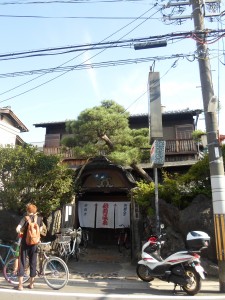 (The outside of the Funaoka Onsen)
(The outside of the Funaoka Onsen)
The Funaoka Onsen has quite the variety of baths. After showering and getting clean, you can hop back and forth into several different baths. Two of these were relatively normal hot water baths, one was tiled and the other was made of wood. Then there were the jet baths, with massaging water jets. The last fairly normal bath is located partially outside and is made of rocks. This sento, however, also had:
- An ice cold, freezing, outside bath – which I quite liked for short periods of time
- A boiling hot death bath – I could only stand to immerse my legs in this bath for about 30 seconds
- A sauna – I didn’t use this
- A medicine (kusuri) bath – not sure what was in this bath, but the water had a reddish tint and it was pleasant
- An electrical current bath – I used this for a couple of minutes, and it was a strange experience. You are, quite literally, being electrocuted as you bathe. This seemed to be accomplished by rows of underwater electrical sockets
All in all, the sento was an experience I would highly recommend. I felt extremely relaxed afterward.
My final stop in Kyoto was in Gion, the old style district where the lucky few might catch glimpse of a geisha hurrying down the street between appointments. I was not so lucky, so I just wandered through a few more temples (and more GIANT wooden buildings) before heading back to Osaka, feeling very tired and quite burnt.

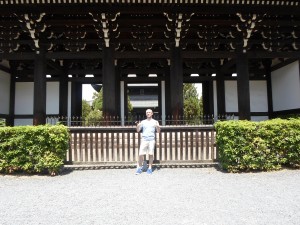
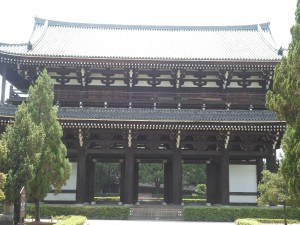
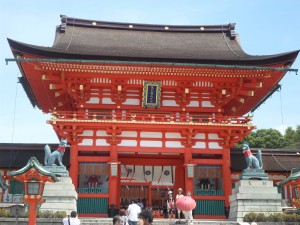
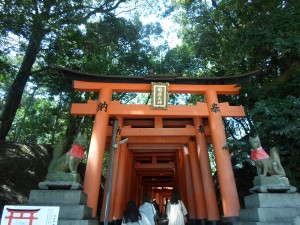
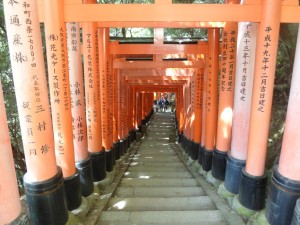
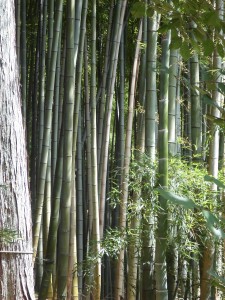
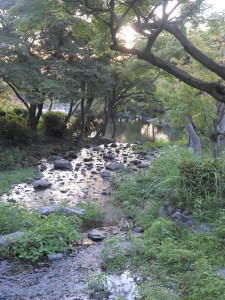
You are a good observer and described your trip to Osaka and Kyoto well. The bamboo forest looks phenomenal and your visit to the baths was very interesting. Michele